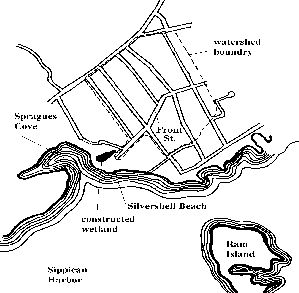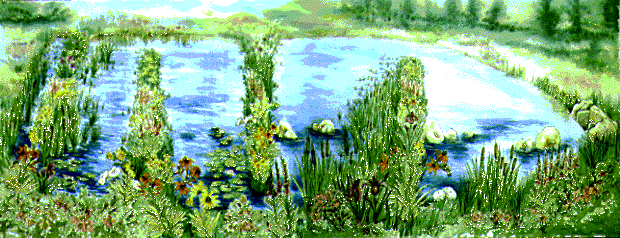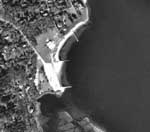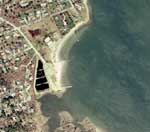Spragues Cove Stormwater Remediation Project: Constructed Wetland System
Spragues Cove is located on the western side of Sippican Harbor in the Town of Marion. The Cove’s shellfish beds, immediately adjacent to the town’s only public bathing beach, were closed in the late 1980s due to bacterial contamination from stormwater runoff. Two storm drain systems discharged into Spragues Cove, the largest of which drains a 64 acre area of roads and driveways in the densely developed lower portions of Marion village.
In 1991, the Town of Marion and the Buzzards Bay Project began exploring options for treating this stormwater runoff prior to discharge. The result was the design (provided by USDA NRCS) and construction of a 3 acre man-made wetland system to treat the “first flush” of stormwater entering the Cove. Stormwater contaminants such as bacteria, sediments, and nutrients are removed through natural physical and biological processes within the staged wetland and open water system. Along with the water quality benefits, the Spragues Cove stormwater wetland provides enhanced wildlife and fish habitat and replaces a filled parking area that was formerly a salt marsh.
The system was constructed in 1995 with funding from the Buzzards Bay Project, an EPA/DEP 319 Nonpoint Source Pollution grant, the Town of Marion, US Fish and Wildlife Service, and private contributions. Once the construction was completed, a large citizen effort was mobilized (with additional funding from the Massachusetts Environmental Trust) to plant the system with a variety of wetland species such as cattail, bulrush, and lily in order to make the system function like a wetland to remove contaminants.
“Without the construction of the Spragues Cove wetland system, we may have been forced to close the cove to shellfishing.”
Frank Germano, Senior Biologist, Massachusetts Division of Marine Fisheries from 1997 Biennial Review
![]()
Spragues Cove constructed wetland: Deep pool, looking North.
“The Spragues Cove drainage remediation project presented the designers and engineers with the Buzzards Bay Project with some unique challenges… These challenges were met head on with careful study and planning, which has produced a very effective drainage remediation project. The results are better than anyone expected. In addition to being an efficient treatment of urban runoff, the Town is left with an extremely pleasing site filled with wetland plants and flowers, the return of native wildlife, and a please citizenry. The introduction of fish in the deep lagoon and improved habitat has reduced the summer mosquito population and has not resulted in a single neighborhood complaint. This is a unique cooperative project in that it combined the resources of the NRCS, Massachusetts DEP, MCZM, US Fish and Wildlife Service, and the Town of Marion.”
Ray Pickles, Executive Secretary Town of Marion, from 1997 Biennial Review
![]()
Spragues Cove constructed wetland: Meandering central wetland.
The Spragues Cove Project has been and continues to be not only an extremely successful stormwater remediation project but an equally important community environmental education and wetlands restoration effort. The construction of the Spragues Cove constructed wetlands stormwater system was an important early success for the Buzzards Bay National Estuary Program, not only in terms of a technical achievement in constructing a large scale restoration project, but equally important, as a collaborative effort involving many agencies, citizen groups, resident partners, and Marion residents at town meeting. The project was not without controversy in the planning stages, and some abutters initially opposed the project. Below is information from reports and memos that piece together the complex events and actions that were required to implement this project.
Project History
Information in this section was taken from and modified from the 1997 BBNEP Biennial Review
In 1990, the town of Marion, concerned with shellfish closures in Spragues Cove and elevated coliform levels at the town beach, submitted a proposal to the Buzzards Bay Project to remediate coliform discharges from Spragues Cove creek, the primary pollution source to the Cove. The Buzzards Bay Project was unable to fund this initiative, but due to the merit of the project, prepared for the town a joint application to the DEP 319 Non Point Source Pollution program. The application was also cosponsored by the USDA Natural Resources Conservation Service (formerly the Soil Conservation Service) which had committed to providing site plans and engineering design work for the town. The town itself had committed land and manpower to implement the effort, and the Buzzards Bay Project agreed to do monitoring and coordinate activities surrounding the stormwater project. The Project also helped the town obtain an additional $15,000 from the US Fish and Wildlife Service, and the town committed an additional $9,000 at Town Meeting in 1994 to meet shortfalls in state and federal funding together with a contribution of $10,000 from the Cove Charitable Trust.
In 1994 the USDA completed designs for a constructed wetland for the site. A constructed wetland was the selected option due to the presence of high groundwater at the site. The proposed site was formerly a salt marsh that was filled in when the harbor was dredged in the 1950’s. The town commenced construction of the wetlands in February of 1995 and completed the project in June, with additional wetland plantings in the summer of 1995, 1996, and spring of 1997.
The Spragues Cove Stormwater Remediation Project covered three acres and consisted of three major components. First stormwater from a 64 acre watershed is conveyed over Front St. and via a stormwater pipe into a Settling Basin. The principal function of this basin is to allow sediments and associated pollutants to settle. The stormwater leaving the settling basin then passes to the first shallow marsh. The wetland vegetation in this marsh filters the water and improve its quality. Next the stormwater enters a so called “deep pool”. The primary function of this deep pool is to provide a refuge for fish populations over winter. These fish populations are important for mosquito control. The deep pool is also an important feature for increasing the residence time of the system, which is approximately 10 days. It is important that water be held in the constructed wetlands over many days to enhance the removal and treatment of pollutants. After the water leaves the deep pool, it then enters the second marsh, and eventually discharges through a pipe into Spragues Cove.
Before and after construction, the Buzzards Bay Project tested stormwater discharges at the site. When evaluating the effectiveness of this stormwater system it is important to realize that discharges to Spragues Cove are now detained for many days in the wetland. To evaluate the effectiveness of the constructed wetlands, water volumes and pollutant concentrations must be documented both entering the system and leaving it over the residence of the water in the system. Formerly stormwater discharged to the old drainage ditch was immediately discharged to Spragues Cove, and what came into the ditch flowed into the Cove with little pollutant removal. Prior to construction of the wetland, stormwater was monitored in the ditch on several dates. In general we observed lower fecal concentrations during winter and dry periods, and higher concentrations in summer and during wet periods. Of note were the exceptionally high fecal levels observed (20,000 fecal coliforms per 100 ml) on September 10, 1993 after a very heavy rain following a prolonged dry period. Fecal coliforms flowed through the ditch to Spragues Cove with little attenuation. Under less extreme conditions when the front street discharge was lower in fecal coliforms, but often counts were above 1000 fecal coliform.
During the first summer after construction of the wetland, a heavy rain occurred after a prolonged dry period, much like the September 1993 sampling. The results of this sampling is shown in the Figure, the constructed wetlands worked exceptionally well, and met our expectations with a 95% reduction in fecal coliform just on the first day of the rainfall (input to the wetland=15,000 fc/100ml, output = 800 fc/100 ml). Even during dryer periods during the first year, the wetland proved effective (input to the wetland=150 fc/100 ml, output = <10 fc/100 ml).
In contrast to the 1995 monitoring, water quality data from 1996 showed often markedly worse conditions in the wetlands on some dates than the inputs to the wetlands. We believe the high levels observed in parts of the wetland were largely to waterfowl, especially Canada geese, which had taken residence in the wetland, and from saltwater intrusion the base of the system causing dye off of freshwater algae. To address these problems, a new flapper gate was installed in 1996, and the vegetation is no longer mowed on the banks and are now allowed to naturalize. Geese fear predators that lurk in high grass and brush and we expect that with denser vegetation, the geese will no longer remain resident. The Project is further testing the system in the summer of 1997. Samples will also be taken this summer and fall to evaluate the effectiveness of the constructed wetlands in removing nutrients, metals, hydrocarbons, and other contaminants.

Behind the scenes October 1994 agency memo on Spragues Cove
“On Tuesday, October 25th, after a presentation by the Board of Selectmen and the Buzzards Bay Project, residents of the town of Marion at a Special Town Meeting, approved by an overwhelming margin, the expenditure of $19,000 for the completion of the Spragues Cove Stormwater Remediation Project. The work involves the creation of a 2 1/2 acre wetland to treat a stormwater discharge which is causing shellfish bed closures in Spragues Cove in Sippican Harbor and that is also posing a potential health threat to the towns’ only public beach. The artificial wetland is being constructed at the site of a salt marsh that was filled with harbor dredge spoils in the 1950’s.
This work represents one of the most ambitious municipal technical assistance undertakings of the Buzzards Bay Project. The work began in 1991 when the Buzzards Bay Project and the town of Marion jointly submitted a proposal to DEP’s 319 program to construct the artificial wetland. As match, the town of Marion donated the land, valued at $200,000 for this use, and town DPW in kind services. The town not only received the $25,000 319 grant, but with the help of the Buzzards Bay Project, obtained a $10,000 US Fish and Wildlife Grant for wetland restoration. During 1992 and 1993, the Buzzards Bay Project, in partnership with the USDA Soil Conservation Service, developed the engineering designs and site plans for the project, and worked with state, federal, and local agencies to obtain the myriad of permits necessary to undertake a project of this kind. In some cases, complex regulatory and management issues had to be resolved.
In 1994 the stormwater remediation project languished because of some unanticipated expenses, and concerns by some abutters. The Buzzards Bay Project worked collaboratively with the town to address most of these issues, but until this month a $35,000 shortfall was anticipated by the town. Thanks to a private $10,000 grant, donations of plant materials, and some modest design changes, the shortfall was reduced to $19,000 which came before the Special Town Meeting.”
Ground breaking is expected in January, with the remediation project completed by May. Another highlight of the project is that the vegetation plantings will be conducted by volunteers organized by the citizen non-profit Buzzards Bay Coalition. These volunteers will be overseen by SCS, Buzzards Bay Project, and other state personnel. [We hope to get some high level state officials to participate in a planting event too!]. The Buzzards Bay Coalition was instrumental in calling attention to the importance of this effort to Marion voters. This project is an illustration of how different levels of government can collaborate to solve a problem, and demonstrates the importance of public and private involvement and participation in addressing complex pollution issues.”
Information on flyer handed out to residents.
In 1996, additional funds were received from Massachusetts Environmental Trust to organize additional plantings and outreach. Buzzards Bay interns Michael Berkal and Christina Brokaw participated in this effort. Here is an Agenda for a meeting with Marion residents to explain the benefits and outcomes of the Spragues Cove Project. Also read this 1997 Final Report (missing attachments) to MET.
Information from a 1990s fact sheet on Spragues Cove
The Problem
Spragues Cove is a three-acre area of valuable shellfish beds located in the western section of Sippican Harbor in the Town of Marion. The watershed north and west of the cove is moderately settled with single family homes. Shellfish beds at the cove are currently closed to harvest because it exceeds state and federal fecal coliform bacteria standards for shellfishing. A sanitary survey conducted by the Massachusetts Division of Marine Fisheries identified stormwater as a major contributor of fecal coliform bacteria to Spragues Cove. As a recreational resource, the area is home to Marion’s sole bathing area, Silvershell Beach that is immediately adjacent to the cove. In 1990, the town of Marion, concerned with shellfish closures in Spragues Cove and elevated fecal coliform bacteria at the town beach, submitted a proposal to the Buzzards Bay NEP to reduce bacteria and other pollutants from Spragues Cove Creek, the primary pollution source to the cove.
The Solution
In cooperation with the town, the Buzzards Bay NEP (BBP) prepared an application for funding from the Department of Environmental Protection’s (DEP) 319 Non-Point Source Pollution Program. The BBP agreed to conduct monitoring and coordinate activities surrounding the stormwater project. The result was a three-acre constructed wetland adjacent to Silvershell Beach to treat stormwater runoff and associated non-point source pollutants from impervious areas (such as roads, driveways and rooftops) in a 64 acre watershed in Marion’s lower village (see map). The site, a former salt marsh now a parking lot, also provided an opportunity to restore coastal habitats. Over the course of the next 18 months, the Buzzard Bay Project worked with the town to acquire four separate grant awards for various phases of the design and construction of the project. In addition to federal funding awarded through a DEP 319 Non-point Source Pollution grant, an additional commitment of $19,000 was provided by the Town of Marion to meet shortfalls in state and federal funding, $10,000 from the US Fish and Wildlife Service, and $10,000 from the Cove Charitable Trust.
The Design
As with many other stormwater initiatives, the Buzzards Bay NEP and Town of Marion were assisted in the development of appropriate stormwater Best Management Practices (BMPs) for this site through the technical expertise of the USDA Natural Resources Conservation Service. Due to poor drainage in Marion resulting from the presence of near-hydric soils, infiltration management strategies were not a viable option. However, sufficient land area existed near Silvershell Beach at Spragues Cove to allow for the use of a constructed wetland as a treatment mechanism to remove most sediments and bacterial contamination – the pollutants of greatest concern. The result was a series of constructed wetland basins adjacent to the Silvershell Beach parking lot to capture and infiltrate the stormwater.
Stormwater from lower Marion village enters the sedimentation/settling basin (the first stage in the wetlands system), where coarse sediments and other particulates settle out and where the majority of pollutants attached to these sediments are removed. From the settling basin, stormwater flows into the first shallow marsh, where vegetation slows the flow of water and provides for an increased retention time. The interior dikes also serve to increase the retention time by increasing flow length within the system. The physical and biological processes that normally occur in a natural wetland treat and remove various pollutants from the water. The deep pool between the two shallow marshes provides a mechanism to reduce potential mosquito problems by providing habitat for fish. Finally, the water enters a stone-lined, vegetated channel before exiting the system into Spragues Cove.
Results
After just one year, aquatic vegetation has grown vigorously within the wetland system. Many seeds and plants established in late spring of 1995 by numerous town volunteers have become established in the shallow marshes and along the periphery of all basins. Intensive sampling over the course of the summer of 1996 indicated an overall reduction in fecal coliform bacteria. Sand, silt, trash, and other debris have been settling in the sedimentation/settling basin rather than being discharged to the cove. Additional wetland plants were also planted in and along the channel to improve soil stability as well as discourage geese. Because large waterfowl such as geese present a potential fecal coliform problem, tall grasses and wildflowers on interior and main dikes will be encouraged to grow to discourage their residence. As vegetation continues to become established, it is expected that coliform counts will continue to decline.
[Final Outcome: in the late 1990s, the Massachusetts Division of Marine Fisheries opened Spragues Cove to shellfishing on a seasonal basis, like the rest of Sippican Harbor. Today, the constructed wetland is a popular site for residents to visit and inspect while at the beach. Turtles, frogs, and birds, and other wildlife are now abundant in the wetlands.








